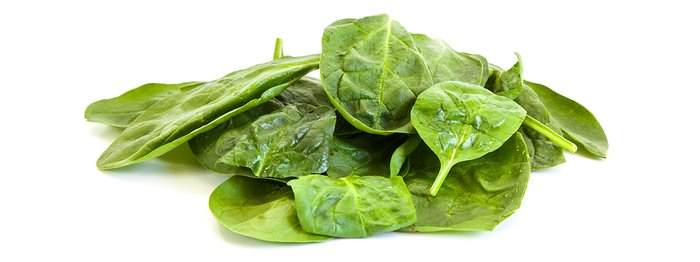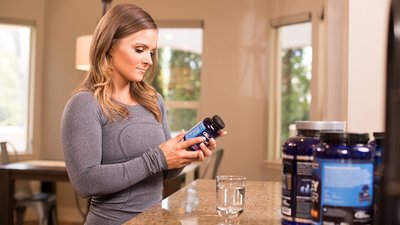Vitamin B complex is a group of water-soluble vitamins that include thiamin, riboflavin, niacin, B6, B12, folate, biotin, and pantothenic acid.[1,2] B vitamins have wide-reaching biological functions, but their most important job is helping to convert nutrients into energy.
The individual vitamins that make up the B complex have specific functions, so it's important to understand the role of each, along with what happens if you don't have enough.
Thiamin/Vitamin B-1
What is thiamin?
Thiamin is a water-soluble B vitamin.
What does thiamin do?
Thiamin plays a major role in energy production, particularly the way your body uses glycogen and breaks down branched-chain amino acids.
What happens when you don't have enough thiamin?
If you're cutting for weight loss, you may be low in thiamin and could benefit from consuming more.[1-3] By reaching appropriate levels of thiamine, you can benefit from improved overall energy metabolism and endurance.[1,2]
Are there side effects of thiamin?
Thiamin toxicity is unlikely because thiamine is water soluble. Any excess vitamin is excreted in urine.
What are the possible interactions of thiamin?
There are no know interactions for thiamin.
Is thiamine found in whole foods?
A variety of foods contain thiamine, such as wheat germ, legumes, pork, and nuts.

What are the available forms of thiamin?
Thiamin is available in gels, tablets, lozenges, capsules, and multivitamins.
How much thiamin do you need?
The recommended dietary allowance (RDA) for thiamin is 1.1 milligrams for females and 1.2 milligrams for males, whether it is met through supplementation or your diet.[4] If you're getting your RDA, don't worry about timing or size of a dose.
Riboflavin/Vitamin B-2
What is riboflavin ?
Riboflavin is a B vitamin absorbed primarily in the small intestine. It's involved in aerobic energy production.
What does riboflavin do?
Riboflavin helps your body convert nutrients into energy. It also helps with cellular function.[1]
What happens when you don't have enough riboflavin ?
Riboflavin deficiency can result in poor performance, although such deficiencies are unusual in athletes. No effects on performance have been found as a result of riboflavin supplementation.[5]
Are there side effects of riboflavin?
There are no know side effects of riboflavin supplementation.
What are the possible interactions of riboflavin?
There are no known interactions between riboflavin and other compounds.
Is riboflavin found in whole foods?
Riboflavin can be found in foods such as cottage cheese, milk, yogurt, and eggs.

What are the available forms of riboflavin ?
Riboflavin can be found in gels, tablets, capsules, and multivitamins.
How much riboflavin do you need?
The RDA for riboflavin is 1.1 milligrams for females and 1.3 milligrams for males.[4]
Niacin/Vitamin B-3
What is niacin?
Niacin generally refers to two substances: nicotinic acid and nicotinamide.
What does niacin do?
Niacin plays an important role in energy metabolism, as well as in the synthesis of fatty acids and cholesterol.[1,2] It is the pre-workout ingredient that gives your skin that flushed or tingling feeling.
What happens when you don't have enough niacin?
Niacin deficiency can result in a potentially fatal disease called Pellagra, although this is rare and typically occurs in less-developed countries. Niacin supplementation has not been shown to improve athletic performance.[2]
Are there side effects of niacin?
Common side effects of a high dose of niacin include itchy skin rashes, blurred vision, liver complications, and a flushed feeling in the face, arms, and chest.
What are the possible interactions of niacin?
Niacin may interact with certain medications and may even cause bleeding if taken with aspirin.[6] People taking medications should consult their physician before supplementing with niacin.
Is niacin found in whole foods?
Niacin can be found in foods such as beef, poultry, fish, and some whole-grain products.

What are the available forms of niacin?
Niacin is available in gel or capsule form.
How much niacin to you need?
The RDA for niacin is 14 milligrams for females and 16 milligrams for males.[4] The upper limit of consumption is set at 35 milligrams per day.
Vitamin B-6
What is it vitamin B-6?
Vitamin B-6 is a water-soluble vitamin found naturally in many foods and added to many others. It is a term for all biologically active forms including Pyridoxine, pyridoxamine, pyridoxal, pyridoxal phosphate, pyridoxal-5'-phosphate.
What does vitamin B-6 do?
Vitamin B-6 has a variety of functions in the body. It helps synthesize amino acids and break down glycogen for energy. It also plays a role in the production of red and white blood cells. Respectively, these support energy production and immune function.[1]
What happens when you don't have enough vitamin B-6?
Vitamin B-6 deficiency, while rare in athletes, is usually a result of poor food choices. Symptoms can include nausea, impaired immune function, weakness, and anemia. Vitamin B-6 supplementation is unlikely to yield any performance benefits in people who receive sufficient amounts from their diet, although older athletes, vegans, and vegetarians should be sure to get adequate amounts. Vitamin B-6 can also lower homocysteine levels, which can reduce the risk of cardiovascular disease.[7]
Are there side effects of vitamin B-6?
Toxicity can occur in doses over 1,000 milligrams per day and can result in peripheral nerve damage.[1,2]
What are the possible interactions of vitamin B-6?
Vitamin B-6 may interfere with certain antibiotics. People taking medications should consult their doctor before supplementing with B-6.
Is vitamin B-6 found in whole foods?
Vitamin B-6 is found in high-protein foods such as beef, fish, eggs, and poultry.

What are the available forms of vitamin B-6?
B-6 can be found in gels, tablets, capsules, or multivitamins.
How much vitamin B-6 do you need?
The RDA for vitamin B-6 is 1.3 milligrams.[4] The upper limit for vitamin B-6 is 100 milligrams per day.
Vitamin B-12/ Cobalamin
What is vitamin B-12 ?
Vitamin B-12 is a water-soluble vitamin with a variety of health functions.
What does vitamin B-12 do?
Vitamin B-12 helps protect the central nervous system by maintaining the integrity of the myelin sheath, the protective layer around nerve fibers. Vitamin B-12 also plays a role in converting nutrients into energy and in red blood cell production.
What happens when you don't have enough vitamin B-12 ?
Vitamin B-12 deficiency can be a result of not consuming enough of it or in the body's inability to absorb the B-12 that is available. Since vitamin B-12 is found only in animal products, vegans and vegetarians are at a higher risk of developing a vitamin B-12 deficiency. It's unlikely that vitamin B-12 yields any performance benefits in athletes who are getting enough of it from their diet. Like vitamin B-6, vitamin B-12 can lower homocysteine, reducing the risk of cardiovascular disease.[1,2]
Are there side effects of vitamin B-12?
There is no known toxicity of high intakes of vitamin B-12. An upper limit of intake has not been set.
What are the possible interactions of vitamin B-12?
Absorption of vitamin B-12 may be impaired by medications designed to reduce stomach acid.[6]
Is vitamin B-12 found in whole foods?
You can get large amounts of vitamin B-12 from animal products such as dairy, eggs, and meats.

What are the available forms of vitamin B-12?
Vitamin B-12/Cobalamin can be found in gels, tablets, capsules, and multivitamins.
How much vitamin B-12 do you need?
The RDA for vitamin B-12 is 2.4 micrograms for men and women between the ages of 19-50.[4] Appropriate levels can be attained through whole foods, supplementation, or both.
Folate/Folic Acid
What is folate?
Folate is a water-soluble vitamin with a variety of health functions.
What does folate do?
Folate plays a massive role in DNA synthesis and cell division, two important functions in reproductive health.[1] It also aids in tissue repair and the maturation of red blood cells.
What happens when you don't have enough folate?
Consuming adequate folate is critical during pregnancy to avoid complications in the development of the embryo. Folate may also lower the risk of heart disease by lowering levels of homocysteine in the blood.
Are there side effects of folate?
Folate toxicity is rare, although an upper limit has been set at 1,000 micrograms. The main reason for this limit is that high levels of folate can hide B-12 deficiency.
What are the possible interactions of folate?
There are no known interactions.
Is folate found in whole foods?
Food sources of folate include plant-based foods such as legumes, dark-green leafy vegetables, strawberries, and fortified grains.

What are the available forms of folate?
Folate can be found in gels, tablets, capsules, and multivitamins.
How much folate do you need?
The RDA for folate is 400 micrograms per day.
Biotin/Vitamin B-7
What is biotin?
Biotin is a water-soluble vitamin that helps in energy metabolism.
What does biotin do?
Biotin helps convert nutrients into energy and synthesize DNA for healthy cell development.
What happens when you don't have enough biotin?
Your body needs very little biotin, so deficiencies are rare. Very little research has been conducted on biotin for health or performance.
Are there side effects of biotin?
There are no known side effects of a high consumption of biotin, with no upper limit of intake set.
What are the possible interactions of biotin?
There are no known interactions of biotin supplementation.
Is biotin found in whole foods?
Food such as cheese, nuts, green leafy vegetables, and legumes are good sources of biotin.

What are the available forms of biotin?
Biotin can be found in gels, tablets, capsules, and multivitamins.
How much biotin do you need?
There is no current RDA for biotin, but the adequate intake (AI) level for adults is 30 micrograms per day.
Pantothenic Acid/Vitamin B-5
What is pantothenic acid?
Pantothenic acid makes up part of a larger molecule that plays a huge role in energy metabolism.
What does pantothenic acid do?
Pantothenic acid plays a critical part in the body's ability to convert nutrients into energy.
What happens when you don't have enough pantothenic acid?
Symptoms of deficiency include fatigue, impaired coordination, nausea, and sleep disturbances. Pantothenic acid can be obtained from a balanced and varied diet, so deficiencies are rare. There is not sufficient evidence to suggest that pantothenic acid supplementation will improve performance.
Are there side effects of pantothenic acid?
There are no known side effects from supplementation or high doses of pantothenic acid, with no upper limit set.
What are the possible interactions?
There are no known interactions from supplementation.
Is pantothenic acid found in whole foods?
Pantothenic acid can be found in legumes, tomatoes, beef, poultry, and dairy products.

What are the available forms for this ingredient?
Pantothenic acid can be found in gels, tablets and capsules, or in a multivitamin.
How is this ingredient taken?
No RDA has been set for pantothenic acid, but the AI is 5 milligrams per day for adults.
The Bottom Line
Vitamin B complex contains eight vitamins, all of which play varying roles in a range of functions including energy metabolism, reproductive health, and red blood cell production. Research into B vitamins has shown that supplementation is unlikely to yield performance benefits, particularly in those without a deficiency. A well-balanced, varied diet full of good sources of protein, lots of green leafy vegetables, nuts, and legumes typically provides sufficient levels of the B vitamins.
Deficiencies in these vitamins can arise from either poor absorption or inadequate intake of certain foods or overall calories. People at increased risk for deficiencies in certain B vitamins include older adults, vegetarians and vegans, and people who are drastically cutting weight through excess exercise or by lowering their calories. The B vitamins play an important role in the body's ability to produce energy, so it's important to keep these levels high, whether through diet or supplementation.
References
- Haff, G. G. (2008). Essentials of Sports Nutrition Study Guide. Essentials of Sports Nutrition Study Guide: by Gregory G. Haff, ISBN 978-1-58829-611-5. Humana Press, 2008.
- Fink, H. H., & Mikesky, A. E. (2017). Practical Applications in Sports Nutrition. Jones & Bartlett Learning.
- van der Beek, E. J., Van Dokkum, W., Wedel, M., Schrijver, J., & van den Berg, H. (1994). Thiamin, riboflavin and vitamin B6: impact of restricted intake on physical performance in man. Journal of the American College of Nutrition, 13(6), 629-640.
- Institute of Medicine (US) Standing Committee on the Scientific Evaluation of Dietary Reference Intakes. (1998). Dietary reference intakes for thiamin, riboflavin, niacin, vitamin B6, folate, vitamin B12, pantothenic acid, biotin, and choline. National Academies Press (US).
- Winters, L. R., Yoon, J. S., Kalkwarf, H. J., Davies, J. C., Berkowitz, M. G., Haas, J., & Roe, D. A. (1992). Riboflavin requirements and exercise adaptation in older women. The American Journal of Clinical Nutrition, 56(3), 526-532.
- Goldman, R. D., Rogovik, A. L., Lai, D., & Vohra, S. (2008). Potential interactions of drug–natural health products and natural health products–natural health products among children. The Journal of Pediatrics, 152(4), 521-526.
- Miodownik, C., Lerner, V., Vishne, T., Sela, B. A., & Levine, J. (2007). High-dose vitamin B6 decreases homocysteine serum levels in patients with schizophrenia and schizoaffective disorders: a preliminary study. Clinical Neuropharmacology, 30(1), 13-17.

